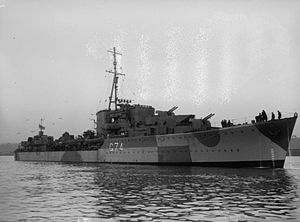L and M-class destroyer

Legion with Type 285 radar aerials on her HA DCT
|
|
| Class overview | |
|---|---|
| Operators: | |
| Preceded by: | J, K and N class |
| Succeeded by: | O and P class |
| Subclasses: | L, M |
| Built: | 1938–42 |
| Completed: | 16 |
| Lost: | 9 |
| Scrapped: | 7 |
| General characteristics as completed | |
| Type: | Destroyer |
| Displacement: |
|
| Length: | 362 ft 3 in (110.4 m) o/a |
| Beam: | 37 ft (11.3 m) |
| Draught: | 10 ft (3.0 m) |
| Installed power: | 48,000 shp (36,000 kW) |
| Propulsion: |
|
| Speed: | 36 knots (67 km/h; 41 mph) |
| Range: | 5,500 nmi (10,200 km; 6,300 mi) at 15 knots (28 km/h; 17 mph) |
| Complement: | 190 |
| Sensors and processing systems: |
|
| Armament: |
|
The L and M class was a class of sixteen destroyers which served in the British Royal Navy during World War II. The ships of the class were launched between 1939 and 1942.
The L class (also known as the Laforeys) were approved under the 1937 Naval Estimates. Four of these ships (Lance, Lively, Legion and Larne) were built with 4-inch (100 mm) armament instead of 4.7 inch. Six of the eight were war losses, with the surviving pair being broken up in 1948.
The M Class were built under the 1939 Naval Estimates. They served in the Home Fleet until 1944 and then went to the Mediterranean. Three were wartime losses; of the five survivors, the Musketeer was broken up in 1955 and the other four sold to Turkey in 1958.
The armament of the class was subject of considerable debate, as the proponents of heavier anti-aircraft armaments for such vessels were at last beginning to be listened to by the Admiralty. This came mainly as a result of the lessons learned during the Spanish Civil War - i.e., military aircraft were now sufficiently advanced to pose a major threat to land and sea targets.
The ships of the L and M class had single funnels, like the previous J class, a tripod foremast and a short mainmast just aft of amidships. One feature of note was the bridge design. From the I class to the Weapon class, all Royal Navy destroyers shared a distinctive wedge-shaped face to the bridge, incorporating a bulletproof wheelhouse, raised in order that the helmsman could see over the guns. The increased height of the new gunhouses of the L class meant that the wheelhouse was raised further, and the sloped roof of the wheelhouse (to direct the airflow over the compass platform) was almost flat. This feature was unique to the L and Ms.
As ordered, the class comprised a leader and 7 destroyers. Each ship was to mount six 4.7-inch (120 mm) guns and 8 torpedo tubes. Close range armament had still to be decided, with the expected time of delivery being a crucial factor.
...
Wikipedia
